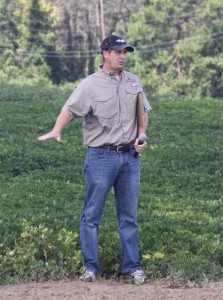 Scott Tubbs, University of Georgia cropping systems agronomist, started his presentation by letting everyone know that it would take longer than 10 minutes for him to address all of the issues of the 2014 peanut crop. The update he provided gave everyone insight into the issues farmers have faced all season from delayed planting due to wet fields to weeks without rains during the critical water use time frame for peanuts. So, Tubbs took his 10 minutes and more to explain the 2014 crop.
Scott Tubbs, University of Georgia cropping systems agronomist, started his presentation by letting everyone know that it would take longer than 10 minutes for him to address all of the issues of the 2014 peanut crop. The update he provided gave everyone insight into the issues farmers have faced all season from delayed planting due to wet fields to weeks without rains during the critical water use time frame for peanuts. So, Tubbs took his 10 minutes and more to explain the 2014 crop.
At the beginning of planting time, large and consistent amounts of rain delayed land preparation for many farmers that needed to get ready to plant. However, planting stayed “on-time” or slightly ahead of average, he says, since some areas that received early rains in April did not receive as much rain in mid-May, and areas that received large amounts in mid-May did not have as much in late April.
Another issue farmers faced at planting time is soil temperature. Tubbs and other researchers at UGA, recommend planting peanuts after 4” deep soil temperatures are at least 68 degrees F. for three consecutive days. Soil temperatures were up to and above the 68 degrees target but near the end of April 18 temperatures dropped below 60 degrees. Some farmers started planting at the end of April but then another dip in temperature in May delayed planting. Farmers watching the weather forecast likely did not plant, says Tubbs, and some of those that did plant had poor emergence and plant stand issues.
However, on average, if you look at planting history we stayed ahead of the five-year average and ahead of the 2013 crop on planting, Tubbs says. As of May 18, 2014, 50 percent of the peanut plant was planted.
Water is critical during the first five weeks of peanut growth for pod fill and kernel development of early set pods, and for flower initiation and pegging of later peanuts. From weeks 10 to 15, anywhere from 1.5 to 2.1 inches of water per week is needed to sustain maximum growth potential. In July and August, average rainfall in the Southwest corner of the state was around 6 inches for the two months combined, while the crop need is closer to 14-15 inches during that timeframe. Some areas received less than 2 inches of rainfall during that span.
About 50 percent of the peanut crop in Georgia is non-irrigated which has caused some issues with the 2014 crop since those farmers have to rely on rainfall. In some areas farmers had issues with inverted seedlings growing upside, a phenomenon of geotropism. The peanuts were growing toward warmer temperature, which ended up being the soil below the peanut rather than the ambient air temperature above the ground. This was observed for a several day period in some areas in early- to mid-May, but was not widespread and corrected itself aside from a few select plantings trying to emerge in that period.
Farmers have also had issues with two-spotted spider mites and lesser cornstalk borers which eat on the stems and kernels and causes aflatoxin. This usually occurs in the non-irrigated peanuts so Tubbs recommends to growers to keep dryland peanuts and irrigated peanuts separate when harvesting the crop. Farmers have also faced some disease issues with white mold, aspergillus crown rot and tomato spotted wilt virus.
In September many farmers have received some rain but it may be a little too late, Tubbs says. He explains that any flowering or pegging peanuts at this time do not have enough time to mature, so recent rains may help finish off the set crop and advance grade, but will not help yield much except in very late planted peanuts or plants that have a lot of small swelling pods. So, the bottom line is a mixed crop outlook throughout Georgia for peanuts.
